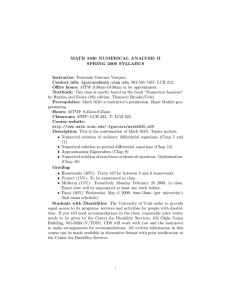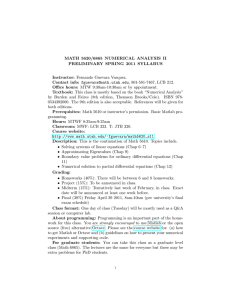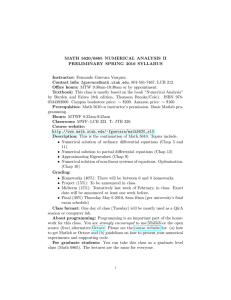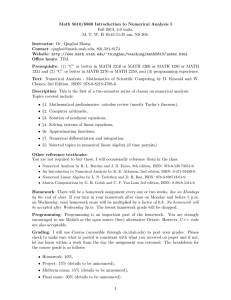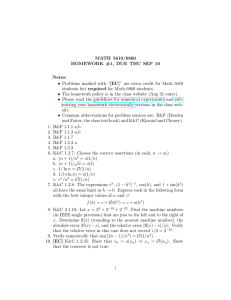MATH 5610/6860 INTRODUCTION TO NUMERICAL ANALYSIS I FALL 2011 SYLLABUS
advertisement
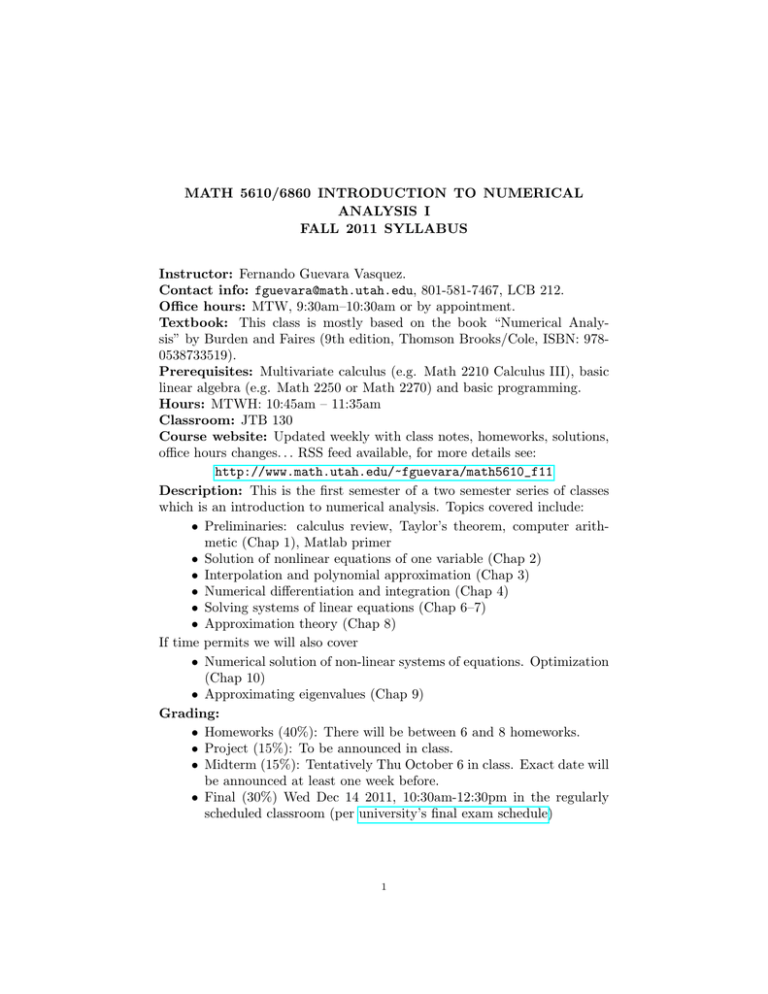
MATH 5610/6860 INTRODUCTION TO NUMERICAL ANALYSIS I FALL 2011 SYLLABUS Instructor: Fernando Guevara Vasquez. Contact info: fguevara@math.utah.edu, 801-581-7467, LCB 212. Office hours: MTW, 9:30am–10:30am or by appointment. Textbook: This class is mostly based on the book “Numerical Analysis” by Burden and Faires (9th edition, Thomson Brooks/Cole, ISBN: 9780538733519). Prerequisites: Multivariate calculus (e.g. Math 2210 Calculus III), basic linear algebra (e.g. Math 2250 or Math 2270) and basic programming. Hours: MTWH: 10:45am – 11:35am Classroom: JTB 130 Course website: Updated weekly with class notes, homeworks, solutions, office hours changes. . . RSS feed available, for more details see: http://www.math.utah.edu/~fguevara/math5610_f11 Description: This is the first semester of a two semester series of classes which is an introduction to numerical analysis. Topics covered include: • Preliminaries: calculus review, Taylor’s theorem, computer arithmetic (Chap 1), Matlab primer • Solution of nonlinear equations of one variable (Chap 2) • Interpolation and polynomial approximation (Chap 3) • Numerical differentiation and integration (Chap 4) • Solving systems of linear equations (Chap 6–7) • Approximation theory (Chap 8) If time permits we will also cover • Numerical solution of non-linear systems of equations. Optimization (Chap 10) • Approximating eigenvalues (Chap 9) Grading: • Homeworks (40%): There will be between 6 and 8 homeworks. • Project (15%): To be announced in class. • Midterm (15%): Tentatively Thu October 6 in class. Exact date will be announced at least one week before. • Final (30%) Wed Dec 14 2011, 10:30am-12:30pm in the regularly scheduled classroom (per university’s final exam schedule) 1 2 MATH 5610/6860 NUMERICAL ANALYSIS I, FALL 2011 Class format: One day of class (Tuesday) will be mostly used as a Q&A session or computer lab. About programming: Programming is an important part of the homework for this class. You are required to use Matlab or the open source (free) alternative Octave. Please see the course website for: (a) how to get Matlab or Octave and (b) guidelines on how to present your numerical experiments and supporting code. For graduate students: You can take this class as a graduate level class (Math 6860). The lectures are the same for everyone. If you take this class as Math 6860 you are required to do some extra work and will be evaluated differently. To be more precise: • There will be extra problems or questions in your homework that require a deeper understanding of the material. They will be clearly indicated and may substitute questions for Math 5610 students. Some of the questions intended for graduate students may be counted as extra credit for the rest of the class. • More rigorous solutions are expected. • The project you choose should be sufficiently challenging (to be discussed with the instructor). Other reference textbooks You are not required to buy these, but I will reference them throughout the class. • Kincaid and Cheney, Numerical Analysis: Mathematics of Scientific Computing (3rd edition, Brooks/Cole), 2001. • Stoer and Burlisch, Introduction to Numerical Analysis, Springer 1992. • Atkinson, An introduction to Numerical Analysis, Second Edition, Wiley 1988. • Trefethen and Bau, Numerical Linear Algebra, SIAM 1997. • Golub and Van Loan, Matrix Computations, John Hopkins 1996. Students with Disabilities: The University of Utah seeks to provide equal access to its programs, services and activities for people with disabilities. If you will need accommodations in the class, reasonable prior notice needs to be given to the Center for Disability Services, 162 Olpin Union Building, 581-5020 (V/TDD). CDS will work with you and the instructor to make arrangements for accommodations. All written information in this course can be made available in alternative format with prior notification to the Center for Disability Services.
